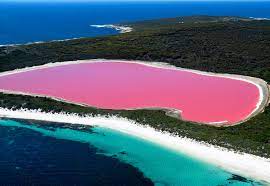Pink River- Australia
Written by Aniketh Kumar on August 26, 2023
It’s all about the algae
Hutt Lagoon’s striking pink colour is thanks to algae that live in the water, Dunaliella salina. When exposed to sunlight, the algae produces beta-carotene, the red pigment found in carrots and other vegies. Thanks to those colour-producing properties, the algae are farmed for use in cosmetics and supplements, and as a natural food dye.
The lagoon covers a whopping 70 square kilometres, tends to be at its pinkest in the mornings, and changes character according to the weather and the seasons.
“If it’s overcast it might look grey or silver,” says Hay. “Or it could go the other way, and the clouds could turn pink because of the reflection. Some days it’s so bright it’s almost purple.”
In summer, much of the lagoon dries out, and the remaining water tends to be a less vibrant pink. “It’s still beautiful in its own right, but it’s different,” Hay says.
The couple’s tours of Hutt Lagoon use a six-seater buggy to take guests over sand dunes for a high-vantage-point view of the lake and encounters with emus, kangaroos and lizards, as well as on a journey through “miles of wildflowers” in spring.
In summer, the tours drive over the dried-out sections of salt bed, and the buggy reveals its significant advantage over traditional 4WD vehicles: it doesn’t sink. “We do recovery mission after recovery mission of people who try and drive over the salt flats,” Hay says. She doesn’t recommend walking on the lake bed for precisely this reason. “It’s very salty and soft, and can be quite slimy.”








